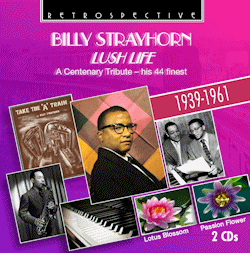CD 1 (1939 – 1949) [79:17]
1. Lush Life [5:57]
2. Take the “A” Train [2:58]
3. After All [3:21]
4. Something to Live for [2:51]
5. Grievin’ [2:51]
6. Weely – A Portrait of Billy Strayhorn [2:58]
7. Lost in Two Flats [2:32]
8. Linger Awhile [3:29]
9. Just A-sittin’ and A-rockin’ [3:34]
10. Clementine [2:59]
11. Passion Flower [3:07]
12. Raincheck [2:29]
13. Chelsea Bridge [2:54]
14. Johnny Come Lately [2:40]
15. Balcony Serenade (first movement of “Perfume Suite”)
16. Tonk [2:46]
17. Drawing Room Blues [3:37]
18. Midriff [3:14]
19. Violet Blue [2:57]
20. Halfway to Dawn [4:11]
21. Tail Spin [4:12]
22. A Flower is a Lovesome Thing [3:14]
23. Lotus Blossom [3:02]
24. Lush Life [3:13]
CD 2 (1950 – 1961) [77:18]
1. C Jam Blues [2:55]
2. Johnny Come Lately [2:57]
3. In a Blue Summer Garden [4:03]
4. Great Times [2:53]
5. Snibor [7:14]
6. Satin Doll [5:01]
7. Cherry [5:52]
8. Gone With the Wind [4:16]
9. Rose Room [6:00]
10. Watch Your Cue [3:06]
11. Chelsea Bridge [3:15]
12. Just A-sittin’ and A-rockin’ [2:50]
13. Strange Feeling (second movement of “Perfume Suite”) [3:38]
14. Something to Live For [2:59]
15. Take the “A” Train [3:15]
16. I Got it Bad and that Ain’t Good [3:35]
17. Don’t Get Around Much Anymore [2:59]
18. The Gal from Joe’s [2:25]
19. Day Dream [3:55]
20. Your Love Has Faded [2:59]
Billy Strayhorn (composer, arranger and pianist) with various instrumentalists and ensembles
Rec. 1939 – 1961 [79:17 + 77:18]
This set was issued to commemorate one of the truly great jazzmen of the previous century in connection with the celebration of his centenary. In spite of
his greatness he was far too little known, working in the shadow of his mentor Duke Ellington but in close collaboration with him – so close that even the
most knowledgeable listeners were at pains to decide: who wrote this, Duke Ellington or Billy Strayhorn? In many cases it wasn’t even one or the other but
both, and there are many examples of this on these two discs. Ellington wrote in his autobiography: ‘Billy was my right arm, my left arm, all the eyes in
the back of my head, my brainwaves in his head and his in mine.’
Quite a few of the 44 numbers – no, not quite 44 since some of the titles are presented in more than one version – are by Ellington, some by other
composers but Strayhorn is involved in each of them in one or several capacities: as composer, as arranger, as pianist. A dozen of the titles are with ‘The
Famous Duke Ellington Orchestra’, the last five, from 1961, with Billy Strayhorn & his Orchestra’ which also is the Ellington orchestra minus the Duke
who is replaced by Jimmy Jones, others are with smaller combos consisting of Ellington musicians, there are six pieces with Duke and Billy as piano duo or
with rhythm group and Billy plays on his own or with a trio. Lush Life, his most famous composition, opens disc 1 in a live recording from
Carnegie Hall in November 1948, introduced by Ellington and sung by Kay Davis with Billy at the piano, and the disc ends with the same song in a recording
from 1949 with Nat King Cole and his trio together with Pete Rugolo and his Orchestra.
With a total playing time of more than 2½ hours this is a superb collection of the art of Billy Strayhorn, and everyone will be able to find his/her
favourites, from the original 1941 recording of Take the “A” train to his last recordings in 1961. Johnny Hodges lush alto saxophone is heard on
many tracks, of which Passion flower (CD 1 tr. 11) and Lotus blossom (CD 1 tr. 23 are especially memorable. Cootie Williams’ long solo in Grievin’ (CD 1 tr. 5) is also something for the desert island. It is also interesting to compare Chelsea Bridge (CD 1 tr. 13) by the
Ellington band in 1941, when it was newly written, with Strayhorn’s solo recording twenty years later (CD 2 tr. 11).
The transfers are excellent and Digby Fairweather’s extensive liner notes are the perfect guide for the listener. So, there is no need to hesitate. An
exemplary historical issue that should be in every jazz collection.
Göran Forsling
See also another review by Tony Augarde
